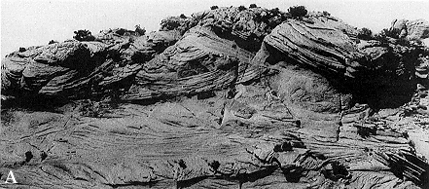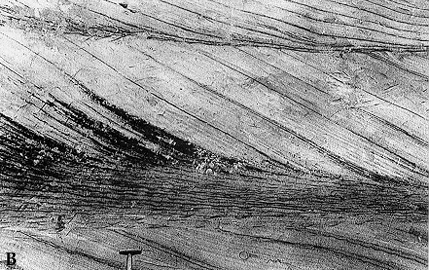

Trough cross-bedding: transversal (A) and longitudinal (B)
sections
Plate 34


Trough cross-bedding: transversal (A) and longitudinal (B)
sections
Plate 34
A longitudinal section is normal to master bedding and parallel to the current direction. Laminae are seen dipping down current at the angle of repose of sand. Three laminasets, corresponding to as many beds, are visible plate 34 A; the handle of a shovel stands for scale at the bottom. The thickness of the central bed, which is truncated atop, is more than one meter; this indicates that the original bed form was larger than a dune, and should be called a sand wave.
What kind of current made it? Here we are observing Recent sands along the Dutch coast of the North Sea, where strong tidal currents are active. Therefore, it seems logical to assume that similar currents were responsible for originating these large tractive structures. A peculiar indicator of tidal influence, moreover, is present and consists of dark bands recurring rather regularly within the foreset. These bands are mud drapes rich in organic matter, marking pauses of slipface advance; similar but thinner mud laminae are present (but not easily visible) within each laminaset. In high-energy tidal environments, mud settles during slack water time, at high and low tide stands, when the current inverts its direction, and its strength becomes insufficient to transport sand. The tide range and the ensuing power of tidal currents vary during a monthly tidal cycle (spring-neap cycle), minimum values being recorded at neap tides, every 14.5 days (half lunar month). These minimums are matched by enhanced slack water effects, resulting in thicker mud drapes.
Two downlap and as many toplap contacts can also be observed in this picture. The toe of the intermediate bed shows an alternation of sand and mud laminae separated by wavy surfaces. These materials accumulated in a trough between sand waves (compare with plate 29, allowing for the different scale). The sand was rippled by waves and draped by mud in slack water phases.
A transversal section contains the vertical direction and the orthogonal to the current. In 34 B, the paleocurrent was at right angles with the page. The shape shown by cross-bedding is that of troughs or festoons, concave-up laminasets separated by scour surfaces (see drawing). This profile can vary, however, with the three-dimensional geometry of the generating bed forms. Forms with linear crests, for example, give transversal sections made of parallel laminae, plane or slightly wavy. Trough cross-bedding reflects markedly three-dimensional, elongated ripples or dunes, whose tops are eroded, while the fill of troughs is preferentially preserved.
Every set in picture B is some meter thick, and represents a phase of migration of Ancient eolian dunes belonging to the Navajo Sandstone, a Jurassic formation of the western U.S. A longitudinal section of the same unit can be seen for comparison in color plate 18. Note that laminae dip in one direction only in sections parallel to flow, in opposite directions in transversal sections. The same criteria for discriminating between longitudinal and transversal sections apply regardless of scale, from sand waves to ripples.
| Photos: G. G. Ori 1992. |